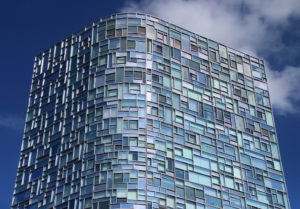
Designed by critically-acclaimed, Pritzker Prize winning architect Jean Nouvel, the 100 Eleventh Avenue Condominium (the “Condominium”) is a 23-story, 73-unit luxury residential condominium building located in Manhattan’s West Chelsea Gallery District. Its most striking and distinctive feature is a complex glass curtain wall comprised of nearly 1,700 irregularly-shaped glass panes stitched together in an intricate, mosaic-like pattern. Light reflects off every angle of the wall and produces an arresting visual effect, which prompted its sponsor/developer to coin it, “The Vision Machine.”
But, as unit purchasers soon learned, the building was anything but a vision of perfection.
Following the completion of construction in 2009, unit purchasers began to move into the building and almost immediately discovered that the building was plagued by a slew of construction and design defects. While it was apparent that the Building’s sponsor/developer had constructed the building defectively, it maintained a stranglehold on the Condominium’s board of managers (the “Board”). The Board therefore would not—and, effectively, could not—sue the sponsor/developer to recover damages.
As a result, one individual unit owner (“Plaintiff”), represented by SSRGA, commenced litigation against the sponsor/developer and related persons and entities (collectively, the “Sponsor”) for construction defects plaguing the Condominium’s common elements. Plaintiff asserted causes of action for breaches of contract and the housing merchant warranty, breach of fiduciary duty, fraud, and fraudulent conveyances. Because the Board could not sue the Sponsor in its own right, Plaintiff sued the Sponsor derivatively, seeking recovery for and on behalf of the Board.
Unbeknownst to Plaintiff’s counsel, however, Plaintiff previously had resolved certain private disputes with the Sponsor pertaining to her individual unit in the building. In resolving those individual claims, Plaintiff had executed an extremely broad release and covenanted not to sue or in any way participate in litigation against the Sponsor.
The Sponsor moved to dismiss the litigation on several grounds, including that the derivative action maintained by Plaintiff was precluded by Plaintiff’s prior release and covenant not to sue. Plaintiff opposed the Sponsor’s motion and cross-moved to substitute/add other Condominium unit owners to prosecute the Condominium’s claims derivatively, together with, or in place of, Plaintiff.
Noting that Plaintiff’s prior release was “extremely broad,” the trial court granted the Sponsor’s motion to dismiss and denied Plaintiff’s cross-motion. In the trial court’s opinion, Plaintiff’s prior release barred even her derivative claims brought on behalf of the Condominium. As for Plaintiff’s cross-motion to substitute/add other unit owners as derivative plaintiffs, the trial court held that their claims would not “relate back” to the time of the filing of Plaintiff’s complaint, and were thus time-barred because the statute of limitations had since run. SSRGA appealed.
On appeal, SSRGA argued that, no matter the breadth of Plaintiff’s prior release, barring the Condominium’s claims on the basis of a release given by Plaintiff individually with respect to her private claims would erode the fundamental distinction between the individual and representative capacities and between direct and derivative litigation.
The Appellate Division, First Department agreed with SSRGA, reinstating the Condominium’s derivative claims and granting Plaintiff leave to amend the complaint to substitute/add other unit owners.
In so holding, the First Department reaffirmed that, as merely one individual unit owner, Plaintiff “could not and did not release the derivative claims on behalf of the unit owners.” The Court further held that Plaintiff’s prior release and covenant not to sue did not preclude the Condominium’s claims being prosecuted derivatively. And, because the derivative claims were not barred by Plaintiff’s release, Plaintiff did not lack standing when the action was commenced and the substitution/addition of other unit owners would relate back to the filing of the original complaint, notwithstanding that the statute of limitations had lapsed. The First Department found the Sponsor’s other, sundry arguments for dismissal to be “largely unavailing.”
But the Sponsor did not stop there: only weeks after losing Plaintiff’s appeal, the Sponsor moved to reargue the First Department’s decision and/or for leave to appeal to the New York Court of Appeals, the state’s highest court.
The crux of the Sponsor’s argument was that the First Department’s decision would “eviscerate” the release executed by Plaintiff in favor of the Sponsor, and that, it would be inequitable to allow Plaintiff to prosecute the Condominium’s claims derivatively. In the alternative, argued the Sponsor, leave to appeal to the Court of Appeals was warranted since the matter involved a settlement agreement, which is favored as a matter of public policy.
SSRGA opposed the motion, exposing it as “procedurally improper, substantively incorrect, and logically flawed.” Procedurally, the Sponsor’s motion was improper because it failed to identify any fact or law overlooked or misapprehended by the First Department, which is a condition precedent to such a motion. Substantively and logically, the Sponsor’s motion again conflated the individual and representative capacities and direct and derivative litigation—calling for a result that would obliterate the very concept of shareholder (and similar) derivative litigation. If the Sponsor wanted protection vis-à-vis the Condominium’s claims, SSRGA argued, it was incumbent upon the Sponsor to obtain a release from and in the name of the Condominium.
As for the Sponsor’s request for leave to appeal to the Court of Appeals, SSRGA maintained that, while settlements are indeed favored as a matter of public policy, this dispute was a private one between two parties, making it inappropriate for appeal to the high court in the absence of some other predicate for such an appeal.
Once again, the First Department agreed with SSRGA, denying the Sponsor’s motion in its entirety.
As a result of SSRGA’s legal acumen and persistence, the Condominium once again is prosecuting its claims against the Sponsor, seeking to hold the Sponsor liable for construction failures and vindicating the rights of the Condominium’s scores of unit owners.
